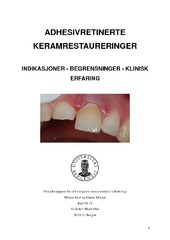| dc.contributor.author | Eftedal, Hanne | en_US |
| dc.contributor.author | Idsø, Helene | en_US |
| dc.date.accessioned | 2011-10-25T11:18:20Z | |
| dc.date.available | 2011-10-25T11:18:20Z | |
| dc.date.issued | 2011-01-26 | eng |
| dc.date.submitted | 2011-01-26 | eng |
| dc.identifier.uri | https://hdl.handle.net/1956/5143 | |
| dc.description.abstract | Adhesively retained ceramic restorations Ceramic restorations have been used as dental treatment for decades. In this article we have focused on adhesively retained ceramic restorations; indications, preparation design, luting procedure, complications and survival rate from other clinical studies. We have also treated our own patients and described the clinical procedure. Successful treatment requires an accurate anamnesis. It is important to find out why the patient has discoloration and/or loss of tooth substance. It is important to discuss alternative treatment options, and help your patient to decide which option is best in their specific situation. Indications for treatment with adhesive ceramic restorations are: teeth resistant to bleaching, major morphologic modifications and replacement of lost tooth substance. There are two main requirements when restoring teeth with adhesively retained ceramic restorations: adequate enamel bonding and possibility for moisture control by rubber dam. Restorations of veneering ceramics must be bonded with an accurate adhesive technique to reach a successful survival rate. When preparing for ceramic restorations you have to consider preparation design and finishline according to the clinical situation, shape and intact hard tissues. It is important that the finished preparation is smooth and has no sharp corners or edges. Ceramic restoration are luted using acid etching, bonding and adhesive cement. Absolute moisture control and a good technique are important to reach a successful survival rate. Clinical investigation have demonstrated good results over a 10 year period for adhesively retained ceramic restorations, but these studies are mostly done on selected patient groups and the treatment are often done by specialists in prosthodontics. To have more reliable results studies where patients are randomly selected, more people in the study and a longer follow-up period are necessary. | en_US |
| dc.description.abstract | Adhesivretinerte keramrestaureringer har blitt benyttet i flere tiår. Formålet med oppgaven var å se nærmere på indikasjoner, begrensninger og klinisk erfaring for denne behandlingsformen. Vi har gjort egne kliniske erfaringer og beskrevet behandlingsprosessen. Vi har også sett nærmere på studier som omhandler suksessfaktorer, overlevelsestid og komplikasjoner av denne restaureringstypen. I oppgaven har vi delt indikasjonene opp i tre hovedgrupper: tenner resistent mot bleking, morfologiske anomalier og erstatte tap/mangel på tannsubstans. To hovedkrav som må oppfylles for å kunne benytte behandlingsformen er tilstrekkelig binding til emalje og mulighet for tørrlegging med kofferdam. Prepareringsdesignet kan ikke standardiseres, det bestemmes ut fra hvert enkelt kasus. Det viktigste er at prepareringsgrensen ligger i emaljen, er jevn og uten skarpe kanter. Fasettene eller skallkronene sementeres ved bruk av etsing, bonding og adhesivsement. Absolutt fuktighetskontroll og god teknikk er viktig for å oppnå et godt og holdbart resultat. Kliniske studier viser gode resultater over en 10 års periode, men disse studiene blir som oftest utført på selekterte pasientgrupper og behandler er ofte spesialist i protetikk. For å få mer pålitelige resultater er det nødvendig med mer tilfeldig utvalgte pasientgrupper, flere pasienter i studien og lengre oppfølgingstid. | en_US |
| dc.format.extent | 1066472 bytes | eng |
| dc.format.mimetype | application/pdf | eng |
| dc.language.iso | nob | eng |
| dc.publisher | The University of Bergen | eng |
| dc.subject | Adhesivretinerte keramrestaureringer | nob |
| dc.title | Adhesivretinerte keramrestaureringer indikasjoner-begrensninger-klinisk erfaring | en_US |
| dc.type | Master thesis | |
| dc.rights.holder | Copyright the author. All rights reserved | |
| dc.rights.holder | The author | |
| dc.description.localcode | MAOD-ODONT | |
| dc.description.localcode | OD3PROSJ | |
| dc.subject.nus | 764106 | eng |
| dc.subject.nsi | VDP::Medical disciplines: 700::Clinical dentistry disciplines: 830::Orthodontics: 833 | eng |
| fs.subjectcode | OD3PROSJ | |
